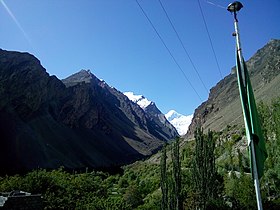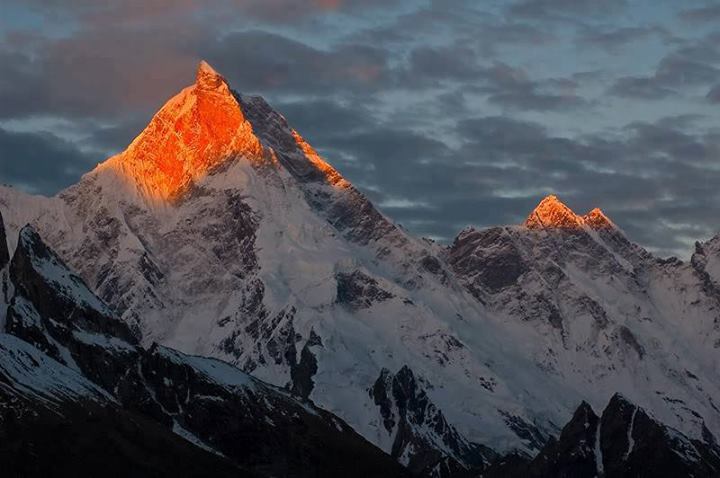Nagarkhas

This article needs additional citations for verification. (December 2008) |
Nagarkhas نگرخاص | |
|---|---|
 Nagarkhas | |
| Coordinates: 36°16′35″N 74°43′12″E / 36.2764°N 74.72°E | |
| Sovereign state | |
| Dependent territory | Gilgit–Baltistan |
| District | Nagar District |
| Elevation | 2,688 m (8,819 ft) |
 | |
Nagarkhas (Urdu: نگرخاص), also known as Oyum-Nagar, serves as the administrative center for the Nagar District in Gilgit–Baltistan region of Pakistan and is one of the main towns of the district. Located along the Nagar River, this town also held the distinction of being the capital of the erstwhile princely state of Nagar.
Today, the renowned Karakoram Highway traverses through Nagar, establishing a crucial connection between Pakistan and China via the Khunjerab Pass. This roadway traces the course of the Hunza-Nagar River for a portion of its journey, passing through Nagar and extending into the Hunza District.
Location
[edit]


Nagar is situated within the Nagar River valley, approximately five miles southeast of the junction where the Nagar River meets the Hunza River, and is positioned just below Baltit.[1]
The Nagar Valley, historically known as Broshal, is situated at an elevation of 2,688 meters (8,822 feet). Nagarkhas, the primary town, also served as the capital of the former princely state of Nagar. Within the Nagar District, the Ghulmet, Minapin, BAR, Chaprote, and Hopper Valleys are renowned tourist destinations due to their breathtaking landscapes. The district is home to some of the world's most imposing high mountain peaks, including Rakaposhi at 7,788 meters (25,561 feet), Diran, the Spantik (also referred to as the Golden Peak), and several others.
Rakaposhi Peak, Nagar (Gulmet)
Hisper Biafo Glacier, Nagar (Hisper)
History
[edit]Following the Hunza-Nagar Campaign of 1889–1892 (known locally as the Anglo-Burusho war) the area came under British control and then became a vassal of the Kashmir durbar but continued to be ruled by the royal family of Nagar. In 1974, Zulfiqar Ali Bhutto dissolved the princely states of Nagar and Hunza and gave them democratic representation in the Northern Areas Council, now known as the Gilgit-Baltistan Legislative Assembly. The British wanted to expand trade with Russia from both Nagar and Hunza, but the states would not permit them to do so.[citation needed]
References
[edit]- ^ Tilman, H.W. (2016), Two Mountains and a River: I made a resolve not to begin climbing until assured by a plague of flies that summer had really come, Vertebrate Publishing, pp. 119–, ISBN 978-1-909461-31-4
Bibliography
[edit]- Nicolaus, Peter (2015), "The Taming of the Fairies", in Uwe Bläsing; Victoria Arakelova; Matthias Weinreich (eds.), Studies on Iran and The Caucasus: In Honour of Garnik Asatrian, BRILL, pp. 225–, ISBN 978-90-04-30206-8
Further reading
[edit]- Leitner, G. W. (1893): Dardistan in 1866, 1886 and 1893: Being An Account of the History, Religions, Customs, Legends, Fables and Songs of Gilgit, Chilas, Kandia (Gabrial) Yasin, Chitral, Hunza, Nagyr and other parts of the Hindukush, as also a supplement to the second edition of The Hunza and Nagyr Handbook. And An Epitome of Part III of the author's "The Languages and Races of Dardistan". First Reprint 1978. Manjusri Publishing House, New Delhi.
- Where three Empires meet by E.F.Night.
- Buroshall Say Nagar Tak ka Safar by Mohammad Ismail Tehseen.
- Brushaal Ke Qabail by Syed Yahya Shah
- Rakaposhi Nagar (راکاپوشی نگر) (Travelogue, 2015) by Mustansar Hussain Tarar



